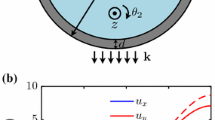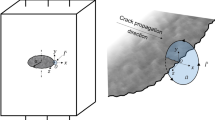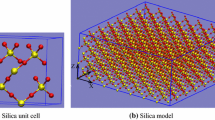Abstract
A quantitative ring contraction model for the fracture of amorphous silica is described based upon AM-1 semiempirical molecular orbital calculations of strained three- and four-fold silica rings and a five-fold ring-chain structure. The fracture barrier for five-fold ring-chain structures is 103 kcal mol−1. The barrier for fracture of a three-fold ring is 96 kcal mol−1. Fracture by contraction of four-fold rings has a lower energy barrier of 77 kcal mol−1 due to formation of pentacoordinate silicon transition states which produce trisiloxane rings and a broken siloxane bond. Thus, the ring contraction model predicts that a crack will follow a path which depends on the distribution of four-fold (or larger) rings in vacuum or fast fracture.
Similar content being viewed by others
References
C. E. Inglis, Trans. Inst. Nav. Arch. 55 (1913) 219.
A. A. Griffith, Trans. R. Soc. Lond. 221 (1921) 163.
S. W. Freiman, in “Glass Science and Technology”, Vol. 5, “Elasticity and Strength in Glass”, edited by D. R. Uhlmann and N. J. Kreidl (Academic Press, New York, 1980) pp. 21–79.
J. H. Simmons, T. P. Swiler and Romulo Ochoa, J. Non-Cryst, Solids 134 (1991) 179.
J. J. Mecholsky Jr and S. W. Freiman, J. Am. Ceram. Soc. 74 (1991) 3136.
T. A. Michalske and B. C. Bunker, J. Appl. Phys. 56 (1984) 2686.
M. J. S. Dewar, E. G. Zoebisch, E. F. Healy and J. P. Stewart, J. Am. Chem. Soc. 107 (1985) 3902.
M. J. S. Dewar and C. Jie, J. Am. Chem. Soc. 6 (1987) 1486.
MOPAC Version 6.1, Tektronix, Inc., CaChe Scientific, Beaverton, OR.
L. P. Davis and L. W. Burggraf, in “Ultrastructure Processing of Advanced Ceramics”, edited by J. D. Mackenzie and D. R. Ulrich (Wiley, New York, 1988) p. 367.
L. W. Burggraf, L. P. Davis, and M. S. Gordon, in “Ultrastructure Processing of Advanced Materials”, edited by D. R. Uhlmann and D. R. Ulrich (Wiley, New York, 1992) p. 47.
M. S. Gordon, Iowa State University (1993), private communication.
F. L. Galeener, J. Non-Cryst. Solids 49 (1982) 53.
A. G. Revesz and G. V. Gibbs, in “The Physics of MOS Insulators”, edited by G. Lucousky, S. T. Pantelides and F. L. Galeener (Pergamon, New York, 1980) pp. 92–6.
Author information
Authors and Affiliations
Rights and permissions
About this article
Cite this article
West, J.K., Hench, L.L. Silica fracture. JOURNAL OF MATERIALS SCIENCE 29, 3601–3606 (1994). https://doi.org/10.1007/BF00357324
Received:
Accepted:
Published:
Issue Date:
DOI: https://doi.org/10.1007/BF00357324




